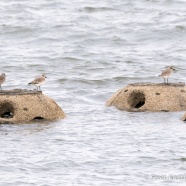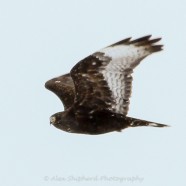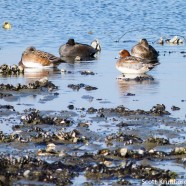Black-bellied Plovers
These Black-bellied Plovers (Pluvialis squatarola) are roosting on the Stratford Point reef balls that were a part of the living shoreline expansion. This has not been an uncommon sight as long-legged waders, ducks, and other shorebirds (a big flock of Dunlin this past Sunday!) have been spending time resting on them at higher tides. It is only the beginning of the action for this restoration with much planned here for 2017…
Read MoreWestern Sandpiper (Calidris mauri)
Fall shorebirding can be very rewarding in a number of diverse habitats including farm fields, parking lots with pools of water, muddy pastures, grasslands, beaches, and rocky shorelines. Whether they are foraging, preening, or roosting there are always good chances to examine shorebirds for prolonged periods. That does not mean the task of identifying them will be easy! For every readily identifiable bird like the American Oystercatcher there seem to be a few difficult to discern species. The juvenile Western Sandpiper (Calidris mauri), as seen below and photographed in late August, can be...
Read MoreWinter Raptor Internship
There are a number of bird species that call Chautauqua County their home. In particular, there are two species, Northern Harriers (Circus cyaneus) listed as ‘threatened’ and Short-eared Owls (Asio flammeus), listed as ‘endangered’ in New York. The Roger Tory Peterson Institute is now in its third year of helping the DEC conduct surveys for these birds. The primary focus of these surveys is to determine where Northern Harriers and Short-eared Owls are spending their time to roost and feed during the winter months. The Northern Harrier is rather distinctive from a long distance with a slim,...
Read MoreResting Eurasian Wigeon
If you are participating in the Great Backyard Bird Count later this week be mindful of finding rarities like this Eurasian Wigeon in Stratford, Connecticut. You can find the species among American Wigeon most often, like this alert drake looking at me and the camera resting with some of its new American friends. Even when they tuck their heads in to sleep you can find that dark reddish/orange head with the buff-colored crown floating on the water and standing out from the green surrounding it. This upcoming Friday through Monday will be frigid but hopefully very productive birding! Scott...
Read MoreLong-eared Owl (Asio otus)
Here’s an old photo from one of my point and shoot cameras, zoomed in quite far about 30 times and further cropped, of a Long-eared Owl (Asio otus) roosting in a tree. Taking such a photo during the daylight hours, in the bright winter sun, of such a sensitive bird species should only be done from far away. You do not want to risk disturbing or flushing them from their location as Long-eared Owls are especially sensitive to human intrusion. They will be alarmed easily and fly from the location, exposing them to attacks from other predators and mobbing by songbirds. They will also often...
Read More








